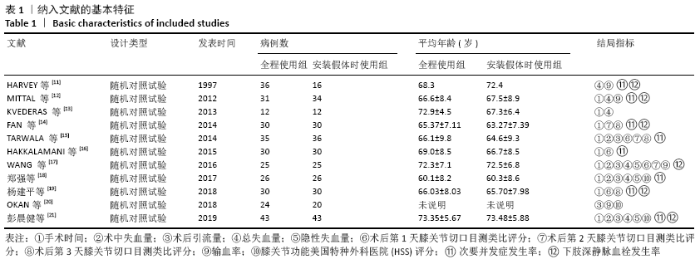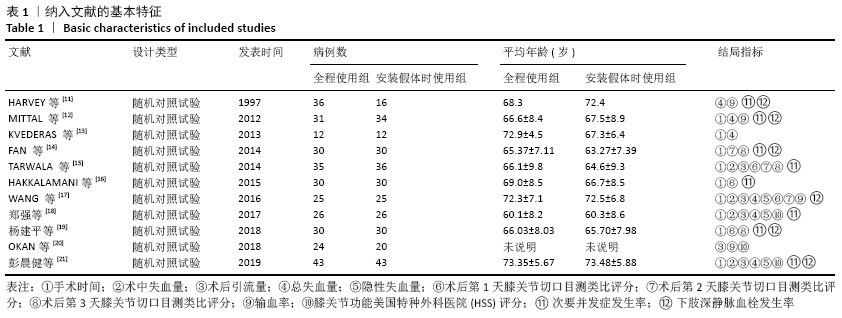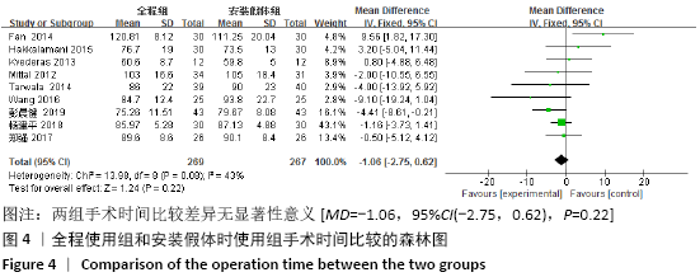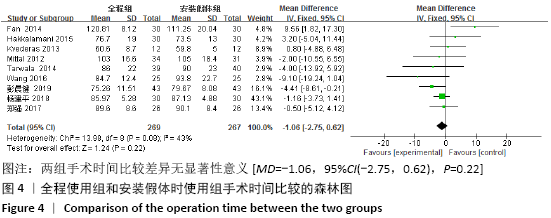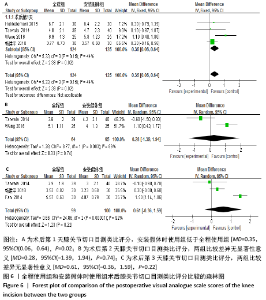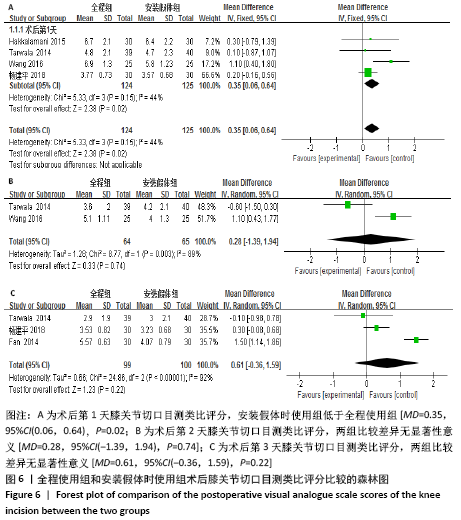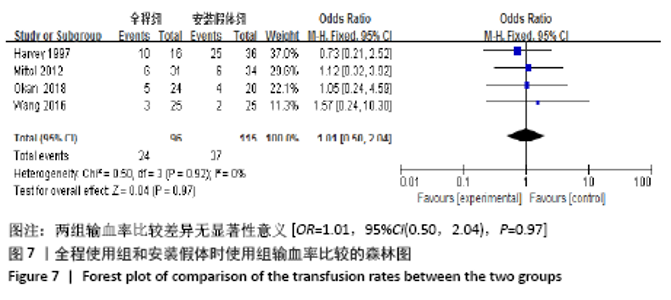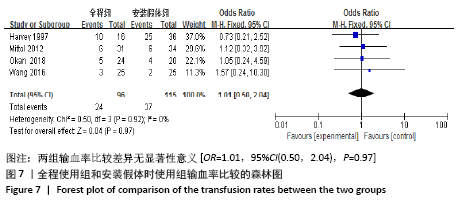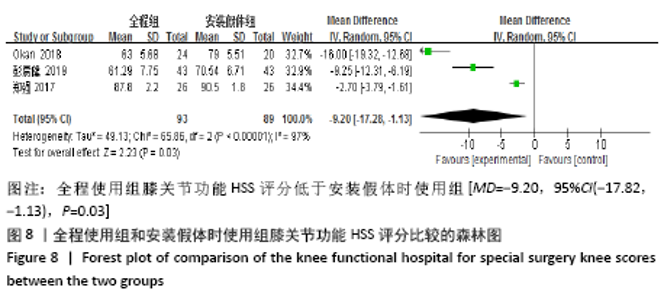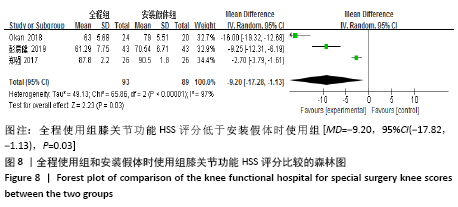Chinese Journal of Tissue Engineering Research ›› 2021, Vol. 25 ›› Issue (18): 2908-2914.doi: 10.3969/j.issn.2095-4344.3833
Previous Articles Next Articles
Efficacy and safety of tourniquet application in total knee arthroplasty and only at the time of cementing: a meta-analysis
Deng Bo, Hong Hainan, Fan Yongyong, Cai Guoping, Feng Xingbing, Hong Zhenghua
- Department of Orthopedics, Taizhou Hospital Affiliated to Wenzhou Medical University, Linhai 317000, Zhejiang Province, China
-
Received:2020-06-28Revised:2020-07-03Accepted:2020-08-07Online:2021-06-28Published:2021-01-12 -
Contact:Hong Zhenghua, Chief physician, Department of Orthopedics, Taizhou Hospital Affiliated to Wenzhou Medical University, Linhai 317000, Zhejiang Province, China -
About author:Deng Bo, Mater, Physician, Department of Orthopedics, Taizhou Hospital Affiliated to Wenzhou Medical University, Linhai 317000, Zhejiang Province, China
CLC Number:
Cite this article
Deng Bo, Hong Hainan, Fan Yongyong, Cai Guoping, Feng Xingbing, Hong Zhenghua. Efficacy and safety of tourniquet application in total knee arthroplasty and only at the time of cementing: a meta-analysis[J]. Chinese Journal of Tissue Engineering Research, 2021, 25(18): 2908-2914.
share this article
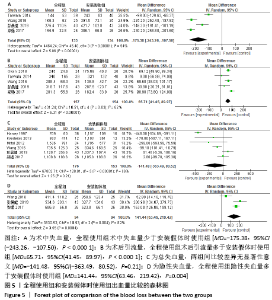
2.3.2 失血量 4项研究报道了术中失血量[15,17-18,21],结果显示全程使用组少于安装假体时使用组[MD=-175.38,95%CI(-243.26,-107.50),P < 0.000 1],见图5A;5项研究报道了术后引流量[15,17-18,20-21],结果显示全程使用组多于安装假体时使用组[MD=65.71,95%CI(41.45,89.97),P < 0.000 1],见图5B;6项研究报道了总出血 量[11-13,17-18,21],结果显示两组总出血量比较差异无显著意义[MD=-141.48,95%CI(-363.49,80.52),P=0.21],见图5C;3项研究报道了隐性失血量[17-18,21],结果显示全程使用组多于安装假体时使用组[MD=141.44,95%CI(63.46,219.42),P=0.004],见图5D。 "
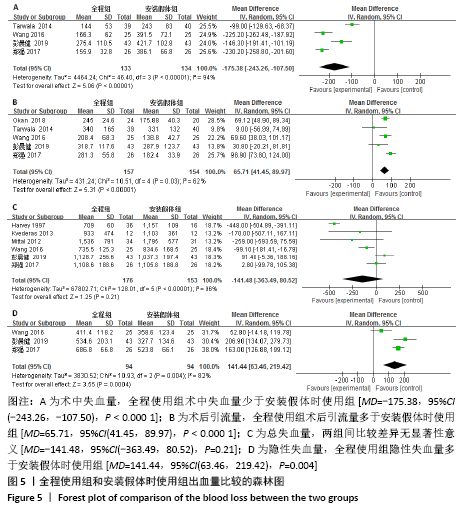
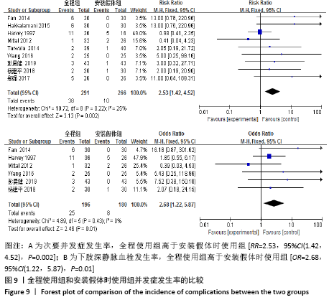
2.3.6 次要并发症发生率及下肢深静脉血栓 9项研究报道了次要并发症发生率[11-12,14-19,21]。9项研究的同质性较好(P=0.22,I2=25%),采用固定效应模型进行分析。结果显示,全程使用组的次要并发症发生率高于安装假体时使用组[RR=2.53,95%CI(1.42,4.52),P=0.002],见图9A。6项研究报道了下肢深静脉血栓[11-12,14,17,19,21]。6项研究的同质性较好(P=0.43,I2=0%),采用固定效应模型进行分析。结果显示,全程使用组的下肢深静脉血栓发生率高于安装假体时使用组[OR=2.68,95%CI(1.22,5.87),P=0.01],见图9B。 "
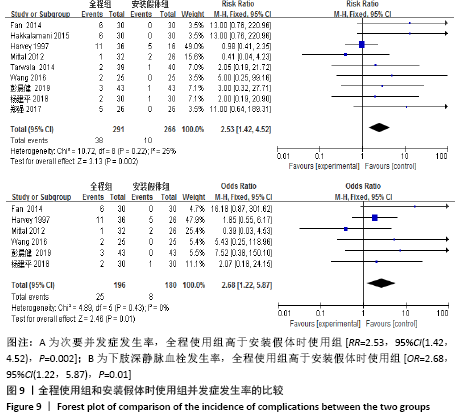
| [1] MURGIER J, LAFFOSSE JM, CAILLIEZ J, et al. Is the prognosis the same for periprosthetic joint infections due to Staphylococcus aureus versus coagulase-negative staphylococci? A retrospective study of 101 patients with 2- year minimum follow-up. Arch Orthop Trauma Surg. 2016;136(10):1357-1361. [2] DUTTON T, DE-SOUZA R, PARSONS N, et al. The timing of tourniquet release and retransfusion drains in total knee arthroplasty:a stratified randomized pilot investigation. Knee. 2012;19(3):190-192. [3] YI S, TAN J, CHEN C, et al. The use of pneumatic tourniquet in total knee arthroplasty: a meta-analysis. Arch Orthop Trauma Surg. 2014;134(10):1469-1476. [4] OLIVECRONA C, PONZER S, HAMBERG P, et al. Lower tourniquet cuff pressure reduces postoperative wound complications after total knee arthroplasty: a randomized controlled study of 164 patients. J Bone Joint Surg Am. 2012;94(24):2216-2221. [5] JIANG FZ, ZHONG HM, HONG YC, et al. Use of a tourniquet in total knee arthroplasty: a systematic review and meta-analysis of randomized controlled trials. J Orthop Sci. 2015;20(1):110-123. [6] ZHANG W, LI N, CHEN S, et al. The effects of a tourniquet used in total knee arthroplasty : a meta-analysis. J Orthop Surg Res. 2014;9(1): 13. [7] OLIVECRONA C, LAPIDUS LJ, BENSON L, et al. Tourniquet time affects postoperative complications after knee arthroplasty. Int Orthop. 2013;37(5):827-832. [8] PETERS CL, CRAIG MA, MOHR RA, et al. Tibial component fixation with cement: full-versus surface-cementation techniques. Clin Orthop. 2003;409(409):158-168. [9] PFITZNER T, VON ROTH P, VOERKELIUS N, et al. Influence of the tourniquet on tibial cement mantle thickness in primary total knee arthroplasty. Knee Surg Sports Traumatol Arthrosc. 2016;24(1):96-101. [10] ZHANG P, LIANG Y, HE JS, et al. Timing of tourniquet release in total knee arthroplasty: A meta-analysis. Medicine (Baltimore). 2017;96(17):e6786. [11] HARVEY EJ,LECLERC J, BROOKS CE, et al. Effect of tourniquet use on blood loss and incidence of deep vein thrombosis in total knee arthroplasty. J Arthroplast. 1997;12(3):291-296. [12] MITTAL R, KO V, ADIE S, NAYLOR J, et al. Tourniquet application only during cement fixation in total knee arthroplasty: a double-blind randombed contolled trial. ANZ J Surg. 2012;82(6):428-433. [13] KVEDERAS G, PORVANECKAS N, ANDRIJAUSKAS A, et al. A randomized double-blind clinical trial of tourniquet application strategies for total knee arthroplasty. Knee Surg Sports Traumatol Arthrosc. 2013;21(12):2790-2799. [14] FAN Y, JIN J, SUN Z, et al. The limited use of a tourniquet during total knee arthroplasty: a randomized controlled trial. Knee. 2014; 21(6):1263-1268. [15] TARWALA R, DORR LD, GILBERT PK, et al. Tourniquet use during cementation only during total knee arthroplasty: a randomized trial. Clin Orthop Relat Res. 2014;472(1):169-174. [16] HAKKALAMANI S, CLARK V, PRADHAN N. Short versus standard duration tourniquet use during total knee replacement: A pilot study. Acta Orthop Belg. 2015;81(1):52-56. [17] WANG K, NI S, LI Z, et al. The effects of tourniquet use in total knee arthroplasty: a randomized, controlled trial. Knee Surg Sports Traumatol Arthrosc. 2017;25(9): 2849-2857. [18] 郑强,尚希福.止血带在全膝关节置换术中不同应用方式的比较研究[J].中国现代医学杂志,2017,27(16):86-89. [19] 杨建平,蒋涛,吕正祥.止血带优化对全膝关节置换术快速康复的影响[J].中国矫形外科杂志,2018,26(1):33-37. [20] OKAN O, KERIM S, HALIL CG, et al. The Effect of Tourniquet Usage on Cement Penetration in total knee arthroplasty: A prospective randomized study of 3 methods. Medicine (Baltimore). 2018;97(4):e9668. [21] 彭晨健,杜斌,孙光权,等.人工全膝关节置换加速康复中优化止血带的使用策略[J].中国组织工程研究,2019,23(28): 4451-4455. [22] ZHOU K, LING T, WANG H, et al. Influence of tourniquet use in primary total knee arthroplasty with drainage: a prospective randomised controlled trial. J Orthop Surg Res. 2017;12(1):172. [23] 马骏,李国庆,曹力.全膝关节置换术中不同压力止血带对术后肿胀及疼痛影响的临床研究[J].中国矫形外科杂志,2013, 21(13):1297-1300. [24] MUYSKENS JB, HOCKER AD, TURNBULL DW, et al. Transcriptional profiling and muscle cross-section analysis reveal signs of ischemia reperfusion injury following total knee arthroplasty with tourniquet. Physiol Rep. 2016;4(1):e12671. [25] EJAZ A, LAURSEN AC, KAPPEL A, et al. Tourniquet induced ischemia and changes in metabolism during TKA: a randomized study using microdialysis. BMC Musculoskelet Disord. 2015;16:326. [26] SHERMAN OH, FOX JM, SNYDER SJ, et al. Arthroscopy- “no-problem surgery”. An analysis of complications in two thousand six hundred and forty cases. J Bone Joint Surg Am. 1986;68(2):256-265. [27] ISHII Y, MATSUDA Y. Effect of the timing of tourniquet release on perioperative blood loss associated with cementless total knee arthroplasty: a prospetive randomized study. J Arthroplasty. 2005;20(8):977-983. |
| [1] | Xu Feng, Kang Hui, Wei Tanjun, Xi Jintao. Biomechanical analysis of different fixation methods of pedicle screws for thoracolumbar fracture [J]. Chinese Journal of Tissue Engineering Research, 2021, 25(9): 1313-1317. |
| [2] | Jiang Yong, Luo Yi, Ding Yongli, Zhou Yong, Min Li, Tang Fan, Zhang Wenli, Duan Hong, Tu Chongqi. Von Mises stress on the influence of pelvic stability by precise sacral resection and clinical validation [J]. Chinese Journal of Tissue Engineering Research, 2021, 25(9): 1318-1323. |
| [3] | Zhang Tongtong, Wang Zhonghua, Wen Jie, Song Yuxin, Liu Lin. Application of three-dimensional printing model in surgical resection and reconstruction of cervical tumor [J]. Chinese Journal of Tissue Engineering Research, 2021, 25(9): 1335-1339. |
| [4] | Zhang Yu, Tian Shaoqi, Zeng Guobo, Hu Chuan. Risk factors for myocardial infarction following primary total joint arthroplasty [J]. Chinese Journal of Tissue Engineering Research, 2021, 25(9): 1340-1345. |
| [5] | Wei Wei, Li Jian, Huang Linhai, Lan Mindong, Lu Xianwei, Huang Shaodong. Factors affecting fall fear in the first movement of elderly patients after total knee or hip arthroplasty [J]. Chinese Journal of Tissue Engineering Research, 2021, 25(9): 1351-1355. |
| [6] | Wang Jinjun, Deng Zengfa, Liu Kang, He Zhiyong, Yu Xinping, Liang Jianji, Li Chen, Guo Zhouyang. Hemostatic effect and safety of intravenous drip of tranexamic acid combined with topical application of cocktail containing tranexamic acid in total knee arthroplasty [J]. Chinese Journal of Tissue Engineering Research, 2021, 25(9): 1356-1361. |
| [7] | Xiao Guoqing, Liu Xuanze, Yan Yuhao, Zhong Xihong. Influencing factors of knee flexion limitation after total knee arthroplasty with posterior stabilized prostheses [J]. Chinese Journal of Tissue Engineering Research, 2021, 25(9): 1362-1367. |
| [8] | Huang Zexiao, Yang Mei, Lin Shiwei, He Heyu. Correlation between the level of serum n-3 polyunsaturated fatty acids and quadriceps weakness in the early stage after total knee arthroplasty [J]. Chinese Journal of Tissue Engineering Research, 2021, 25(9): 1375-1380. |
| [9] | Zhang Chong, Liu Zhiang, Yao Shuaihui, Gao Junsheng, Jiang Yan, Zhang Lu. Safety and effectiveness of topical application of tranexamic acid to reduce drainage of elderly femoral neck fractures after total hip arthroplasty [J]. Chinese Journal of Tissue Engineering Research, 2021, 25(9): 1381-1386. |
| [10] | Wang Haiying, Lü Bing, Li Hui, Wang Shunyi. Posterior lumbar interbody fusion for degenerative lumbar spondylolisthesis: prediction of functional prognosis of patients based on spinopelvic parameters [J]. Chinese Journal of Tissue Engineering Research, 2021, 25(9): 1393-1397. |
| [11] | Lü Zhen, Bai Jinzhu. A prospective study on the application of staged lumbar motion chain rehabilitation based on McKenzie’s technique after lumbar percutaneous transforaminal endoscopic discectomy [J]. Chinese Journal of Tissue Engineering Research, 2021, 25(9): 1398-1403. |
| [12] | Chen Xinmin, Li Wenbiao, Xiong Kaikai, Xiong Xiaoyan, Zheng Liqin, Li Musheng, Zheng Yongze, Lin Ziling. Type A3.3 femoral intertrochanteric fracture with augmented proximal femoral nail anti-rotation in the elderly: finite element analysis of the optimal amount of bone cement [J]. Chinese Journal of Tissue Engineering Research, 2021, 25(9): 1404-1409. |
| [13] | Du Xiupeng, Yang Zhaohui. Effect of degree of initial deformity of impacted femoral neck fractures under 65 years of age on femoral neck shortening [J]. Chinese Journal of Tissue Engineering Research, 2021, 25(9): 1410-1416. |
| [14] | Zhang Shangpu, Ju Xiaodong, Song Hengyi, Dong Zhi, Wang Chen, Sun Guodong. Arthroscopic suture bridge technique with suture anchor in the treatment of acromioclavicular dislocation [J]. Chinese Journal of Tissue Engineering Research, 2021, 25(9): 1417-1422. |
| [15] | Liang Yan, Zhao Yongfei, Xu Shuai, Zhu Zhenqi, Wang Kaifeng, Liu Haiying, Mao Keya. Imaging evaluation of short-segment fixation and fusion for degenerative lumbar scoliosis assisted by highly selective nerve root block [J]. Chinese Journal of Tissue Engineering Research, 2021, 25(9): 1423-1427. |
| Viewed | ||||||
|
Full text |
|
|||||
|
Abstract |
|
|||||
